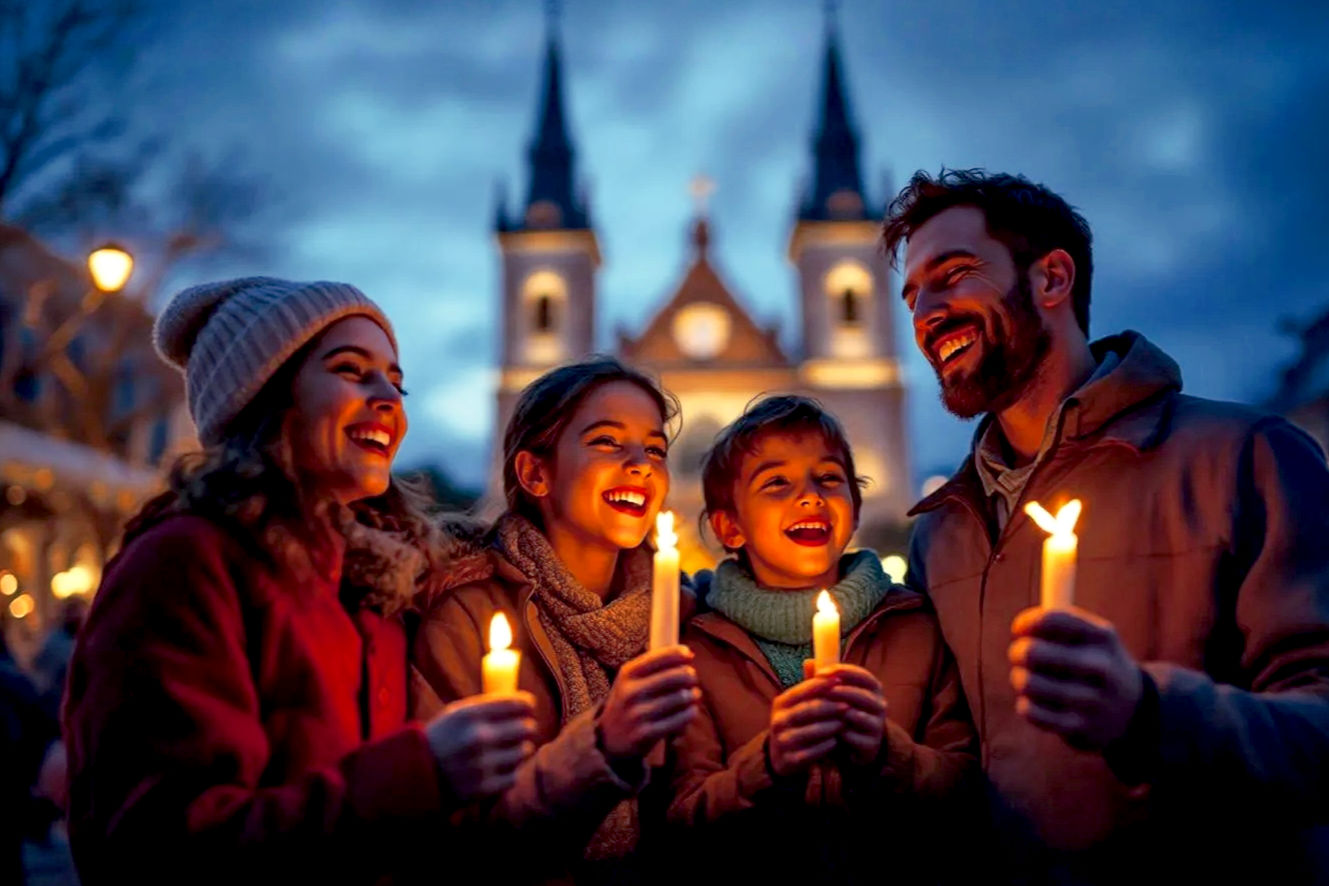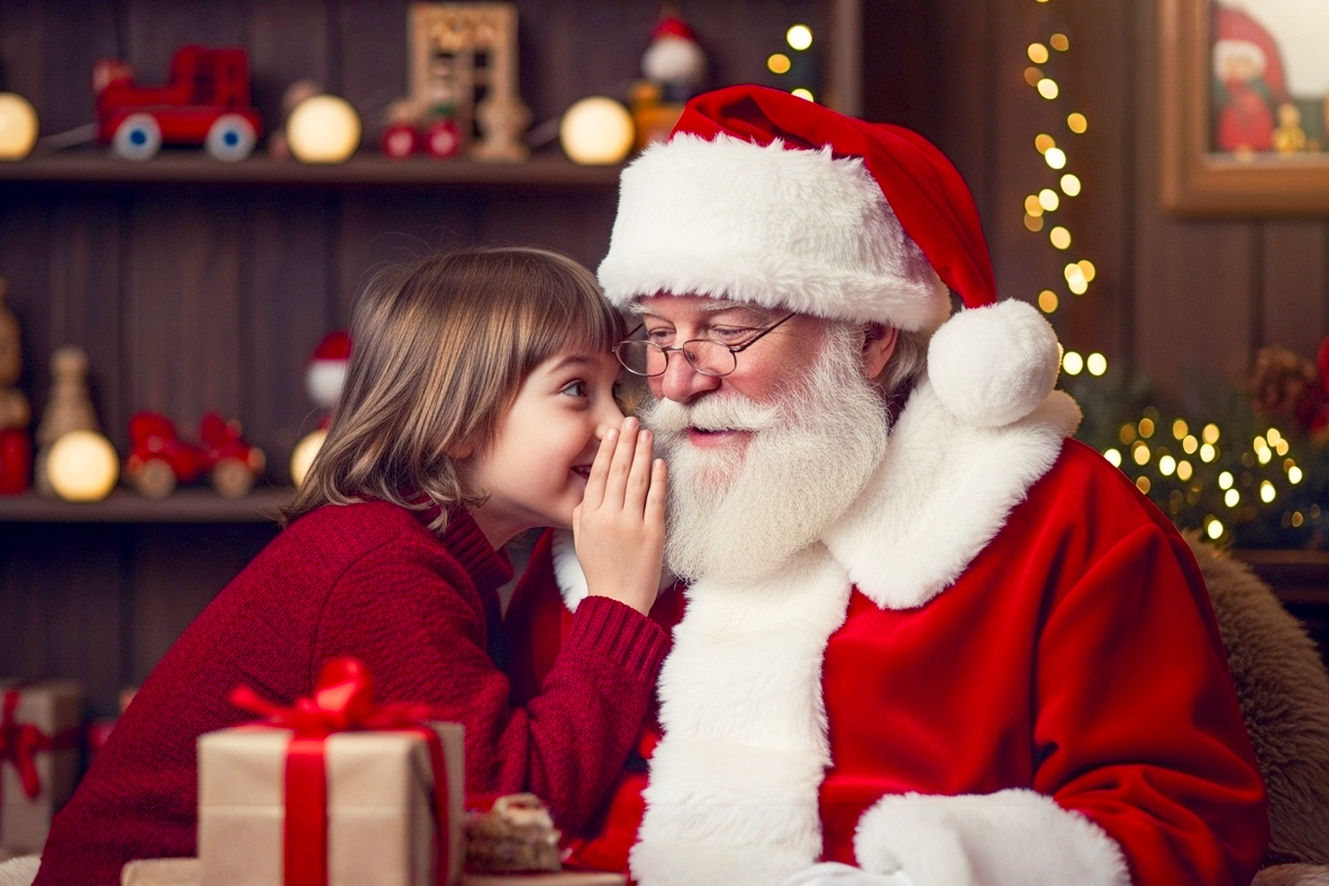This post may contain affiliate links. If you make a purchase through these links, we may earn a commission at no additional cost to you.
The Christmas season, with its vibrant lights, cheerful music, and the palpable energy of gift-giving, is often the most anticipated time of the year. However, for many, the ever-increasing commercialization and busy schedules can cause the holiday’s spiritual core to fade into the background. A Christ-centered Christmas is an intentional effort to reclaim this spiritual focus, shifting the holiday’s central meaning from consumerism to celebration of the birth of Jesus Christ.
This guide will look into the historical, operational, and spiritual aspects of this approach, giving you a complete framework for a more meaningful holiday season. We’ll explore timeless traditions, their profound meanings, and practical ways to integrate them into modern life, ensuring your family’s focus remains on the “reason for the season.”
The Core Philosophy: What a Christ-Centered Christmas Truly Means
Defining a Christ-Centered Christmas
At its heart, a Christ-centered Christmas is a purposeful celebration that places the Nativity—the birth of Jesus—at the forefront. This approach isn’t about eliminating all secular elements, but rather about intentionally prioritizing the sacred over the secular. While a traditional Christmas might feature Santa Claus as the primary figure of giving, a Christ-centered one highlights Jesus as the ultimate gift and the inspiration for selfless generosity. The core concept is a spiritual reorientation of the holiday, moving from a culture of getting to a posture of giving, reflection, and worship.
This philosophy is built on the underlying principle that the story of Christmas is one of profound significance for humanity. It’s an opportunity for spiritual growth, not just festive fun. The celebration becomes a chance to reflect on the meaning of God’s love and the hope that Christ’s birth offers. This perspective gives the season a unique depth, transforming it from a mere holiday into a holy day.
The Biblical and Historical Basis
The foundation for a Christ-centered Christmas is rooted directly in the biblical narrative. The Gospels of Luke and Matthew provide the scriptural accounts of Jesus’s birth. Luke, in particular, offers a detailed and beautiful story of Mary and Joseph’s journey to Bethlehem, the birth of Jesus in a manger, and the joyful announcement to the shepherds. Meanwhile, Matthew recounts the visit of the Wise Men, who followed a star to find the newborn King.
Historically, the celebration of Christmas by early Christians was not always a widespread or fixed event. The precise date of December 25th was not settled for a few centuries, as early believers focused more on Easter as the central Christian holiday. However, as the faith grew, the significance of Christ’s birth became a central focus. The early church fathers sought to provide a meaningful counterpoint to pagan festivals, and the intentional celebration of Christ’s birth on December 25th began to take hold. This historical context shows that even from its earliest days, Christmas was a response to the surrounding culture, seeking to establish a sacred tradition centered on faith.
The Advent Season: A Time of Preparation and Hope
The Christmas season doesn’t begin on December 25th; it starts with the four-week period of Advent. Understanding Advent is crucial for anyone who wants to truly have a Christ-centered Christmas.
Understanding Advent: More Than Just a Countdown
The term “Advent” comes from the Latin word adventus, which means “coming” or “arrival.” It’s a period of preparation that serves a dual purpose. First, it’s a time of eager anticipation and reflection as we prepare to celebrate the historical birth of Christ. Second, it’s a time to look forward to the future, to the Second Coming of Christ. This dual focus gives Advent a profound spiritual weight—it’s both a remembrance of the past and a hopeful look to the future.
The tradition of Advent has its origins in the early church, and for many centuries, it was a season of fasting and penitence, much like Lent. While many denominations today have relaxed the strict fasting rules, the core purpose of preparing one’s heart for the arrival of Christ remains.
The Advent Wreath: A Symbol of Hope
The Advent wreath is one of the most recognizable and powerful symbols of this season. It’s a simple yet deeply meaningful tradition that helps families tangibly mark the passage of time leading up to Christmas.
- Components & Symbolism: The wreath is a circle of evergreen branches, often holly, pine, or fir, symbolizing God’s unending love and the eternal hope that Christ offers. Within the circle are four candles, with a fifth, white candle in the center.
- The Candles: There are typically three purple candles and one pink candle, each representing a specific theme.
- Week 1 (Purple): This is the Prophecy Candle, symbolizing hope and the anticipation of Christ’s birth foretold by the prophets.
- Week 2 (Purple): This is the Bethlehem Candle, symbolizing faith and Mary and Joseph’s journey.
- Week 3 (Pink): This is the Shepherds’ Candle, representing joy. The pink color is a brief break from the solemnity of purple, reminding us of the joy of the shepherds hearing the good news.
- Week 4 (Purple): This is the Angels’ Candle, representing peace and the message of peace brought by the angels.
- The Center Candle (White): This is the Christ Candle. It is lit on Christmas Eve or Christmas Day, signifying that Christ, the light of the world, has come. The white color represents purity.
- Practical Application: You can easily incorporate this tradition into your family’s routine. On each of the four Sundays leading up to Christmas, light the corresponding candle, read a short scripture passage, and say a prayer. This simple act creates a weekly rhythm of anticipation and spiritual focus.
The Jesse Tree: Tracing the Family Line of Jesus
The Jesse Tree is another beautiful Advent tradition that offers a visual, interactive way to trace the biblical story leading up to Christ’s birth.
- Description: The Jesse Tree is a small tree, branch, or banner that is decorated with ornaments each day of Advent. Each ornament represents a different person, event, or prophecy from the Bible, starting with creation and ending with Jesus.
- Biblical Roots: This tradition gets its name from Isaiah 11:1, which prophesies, “A shoot will come up from the stump of Jesse; from his roots a Branch will bear fruit.” Jesse was King David’s father, and this prophecy foretold that the Messiah would be a descendant of Jesse.
- How to Create One: To create a Jesse Tree, you’ll need a small branch in a vase or a simple poster board cut into a tree shape. You then need 25 daily devotions and ornaments. For example:
- Day 1 (Creation): An ornament of a globe or a snake.
- Day 2 (Adam and Eve): An apple ornament.
- Day 3 (Noah): A rainbow or ark ornament.
- …and so on, through Abraham, Moses, David, and all the way to Mary and Joseph.
- This tradition makes the vast history of salvation tangible and accessible for children, helping them understand that Jesus’s birth was not an isolated event but the fulfillment of a long and detailed plan.
The Nativity Scene: A Tangible Story of Humility and Salvation
The Nativity scene, or crèche, is a centerpiece of a Christ-centered Christmas. Its simple beauty and profound symbolism tell the entire story of Christmas in a single display.
History and Origin of the Crèche
The tradition of the nativity scene is often credited to Saint Francis of Assisi. In 1223, while in Italy, St. Francis sought to create a more tangible and visceral way for his community to understand the humility and poverty of Christ’s birth. He received permission from the Pope to set up a live nativity scene in a cave. Using a real manger, hay, and live animals—an ox and a donkey—he re-encreated the scene for the villagers. This was a radical act at the time, as it made the sacred story accessible and relatable to the common person. The tradition quickly spread throughout Europe, and over time, the live scene evolved into the carved and sculpted figures we are familiar with today.
The Symbolic Meaning of Each Figure
Each figure in the nativity scene holds a specific and powerful meaning that contributes to the overall message.
- The Holy Family: At the center are Mary, Joseph, and the baby Jesus. Mary’s presence symbolizes her obedience and faith in accepting her role as the mother of God. Joseph’s presence represents his role as a protector and his faithful guardianship of the family. The infant Jesus, lying in the manger, is the central figure, symbolizing the ultimate gift of God’s love and the incredible humility of the Creator entering the world as a vulnerable baby.
- The Shepherds: Placed nearby, the shepherds represent the common people. When the angels announced the good news, they didn’t go to kings or rulers; they went to the humble shepherds in the fields. This signifies that the message of salvation is for everyone, regardless of social status.
- The Magi (Wise Men): The wise men, or magi, are often depicted arriving later in the story. They represent the gentile world—people who were not part of the Jewish faith—recognizing Jesus as the Messiah. Their journey and the gifts they brought—gold (for a king), frankincense (for a priest), and myrrh (a burial spice, foreshadowing his death)—are symbolic of their acknowledgement of Jesus’s identity as King, High Priest, and future Savior.
- Animals and Setting: The presence of animals and the humble setting of a stable are not incidental details. The manger, a feeding trough for animals, is a stark symbol of Christ’s humility and sacrifice. He was born in poverty, without the comforts of a palace, to demonstrate that his kingdom was not of this world and that his love was for the outcast and the forgotten.
Beyond the Nativity: Rich Traditions from Around the World
A Christ-centered Christmas is enriched by a variety of global traditions that highlight different facets of the Nativity story. These customs provide a deeper, more comprehensive understanding of the holiday’s spiritual meaning.
Saint Nicholas Day (December 6th)
Before the modern, secularized figure of Santa Claus, there was Saint Nicholas.
- Historical Figure: The real Saint Nicholas was a 4th-century bishop in Myra, a Greek city in modern-day Turkey. He was renowned for his piety and charity, especially for his habit of giving gifts to the poor and needy. One of the most famous stories about him is how he secretly provided dowries for three poor girls to save them from being sold into slavery.
- Modern Traditions: Celebrating St. Nicholas Day on December 6th is a wonderful way to honor the historical figure behind the myth. In many European countries, children put their shoes outside on the night of December 5th, hoping to find them filled with treats and small gifts from “Saint Nicholas” in the morning. This tradition separates the figure of the gift-giver from Christmas Day itself, allowing the 25th to focus solely on the birth of Christ.
Christingle: The Light of the World
Christingle is a beautiful and simple tradition, particularly popular in the UK and Germany, that uses a simple orange to teach profound biblical truths.
- Origin and Purpose: Originating with the Moravian Church in Germany in 1747, the Christingle service was designed to make the message of Christmas accessible to children. The word “Christingle” means “Christ-light,” and the entire object is a visual metaphor for Christ’s role in the world.
- Components:
- The Orange: Represents the world and its four corners.
- The Red Ribbon: Wrapped around the orange, it symbolizes the blood of Christ, which was shed for all people.
- The Four Sticks: Inserted into the orange at the cardinal points, they represent the four seasons or the four corners of the world, reminding us that God’s creation is a gift.
- The Sweets or Fruit: Attached to the sticks, they represent the fruits of the Earth and the bounty of God’s creation.
- The Candle: Placed at the top of the orange, it represents Jesus Christ as the Light of the World, shining in the darkness.
The Feast of the Epiphany (January 6th)
The Epiphany, or Three Kings Day, marks the end of the traditional “12 Days of Christmas.”
- Meaning: “Epiphany” means “revelation” or “manifestation.” The holiday celebrates the moment when the Magi arrived to worship the newborn Jesus, revealing him to the wider world as the Son of God.
- Customs: Many cultures have beautiful traditions for Epiphany. In some parts of Europe, people practice “chalking the door,” where a blessing is written in chalk above the front door. The initials of the three Wise Men—Caspar, Melchior, and Balthazar—are combined with the year (e.g., 20 C+M+B 25) as a prayer for protection and blessing for the coming year. Another popular tradition is the King’s Cake (Galette des Rois), a delicious pastry that often contains a small trinket or figurine. Whoever finds the trinket is crowned “king” or “queen” for the day, celebrating the kings who found Jesus.
Family-Focused Traditions: Practical Tips for Keeping Christ at the Center
Here are some practical and powerful ways to make Christ the central focus of your family’s Christmas celebration.
Reading the Biblical Narrative Together
One of the most foundational traditions is simply reading the story from the source.
- Methodology: Don’t just read the story once. Create a family tradition of reading a small portion of the Christmas story from the Gospels of Luke and Matthew each night leading up to Christmas.
- Ideas for Engagement: Use a children’s storybook Bible with illustrations to keep younger kids engaged. Assign different family members to read different parts, or even have a “play” where family members act out the parts of Mary, Joseph, the shepherds, and the angels. This makes the narrative an active and memorable part of the season.
The Birthday Cake for Jesus
This is a simple but incredibly powerful tradition that directly addresses the “whose birthday is it, anyway?” question.
- Concept: On Christmas Day, bake a birthday cake for Jesus.
- Execution: After presents have been opened, gather your family to sing “Happy Birthday” to Jesus, just as you would for any other family member. The act of singing and having a special cake is a joyful and concrete way to acknowledge that the entire day is a celebration of a specific birth. This simple gesture provides an important spiritual anchor point for the day.
Service and Giving: Living Out the Christmas Spirit
The act of giving is a central theme of Christmas, but a Christ-centered approach encourages giving in a way that reflects Christ’s own selflessness.
- Focus on Charity: Connect your family’s giving to the biblical message. Christ gave his life for humanity, so our giving should be an echo of that love.
- Practical Ideas: Rather than just focusing on presents for one another, plan a family service project. Volunteer at a local food bank or homeless shelter. Participate in a toy drive for children in need. “Adopt” a family through a church program and buy gifts for them. These acts of charity teach your children the true meaning of generosity and are a direct application of the Christmas message.
Navigating the Secular World: How to Bridge the Gap
It can be a challenge to keep a Christ-centered focus when the world around you is pushing a different message. It’s not about isolating your family, but about finding a healthy balance.
Integrating Secular and Sacred Traditions
You don’t have to throw out every secular tradition. You can choose to find new meaning in them.
- The Christmas Tree: The tree, a symbol of eternal life in some traditions, can be a great visual reminder. You can decorate it with ornaments that tell the story of Jesus, like a star for the star of Bethlehem, or a shepherd’s crook.
- Santa Claus: Instead of viewing Santa as a fictional gift-giver, you can choose to tell the story of St. Nicholas, the real man whose love and generosity inspired the legend. You can explain to your children that Santa is a fun character, but the real spirit of giving comes from the example of Christ and people like St. Nicholas.
Addressing Santa with Your Children
For many parents, navigating the Santa Claus tradition can be tricky. Here’s a balanced approach:
- Acknowledge the Fun: Don’t dismiss the joy and excitement Santa brings. You can treat it as a fun, imaginative game.
- Provide Historical Context: Share the story of St. Nicholas. This provides a historical grounding for the tradition and highlights the virtue of secret giving.
- Prioritize the True Story: Make it clear that while Santa is fun, the real story of Christmas—the birth of Jesus—is the most important part of the holiday.
Defending Your Faith-Focused Holiday
You may encounter well-meaning friends or family who don’t understand your focus. It’s important to be prepared to explain your choices politely and confidently. You don’t need to be preachy or judgmental. Simply state that your family has chosen to celebrate Christmas in a way that emphasizes its spiritual meaning, and that this focus brings you a deeper sense of joy and purpose.
Conclusion: The Enduring Power of a Purposeful Christmas
The Christmas season, at its best, is about more than just presents and parties. It’s a time of profound spiritual significance. By embracing a Christ-centered approach, you can move past the commercial noise and rediscover the true meaning of the holiday. Traditions like the Advent wreath, the Jesse Tree, and the nativity scene aren’t just quaint customs; they are powerful tools for teaching the story of Christ’s birth and its implications for our lives.
Celebrating in this way offers a lasting gift: the joy and peace that come from remembering the hope, love, and salvation that Jesus Christ’s birth represents. It’s an opportunity to create memories and traditions that will enrich your family’s life and deepen your faith for generations to come. A purposeful Christmas is a powerful one, and it’s a gift you can give your family year after year.






